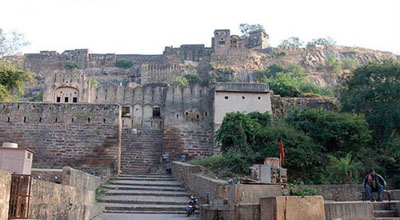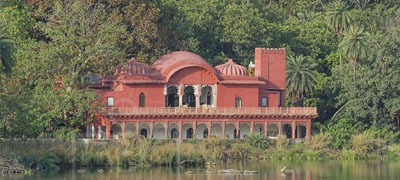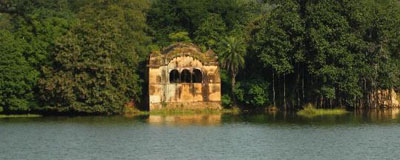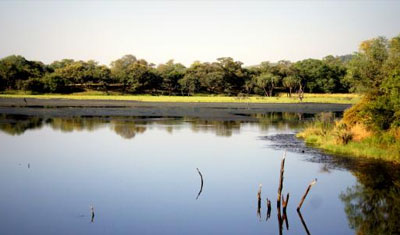Place to see in Ranthambore
Ranthambhor national park is situated 14 kms. From sawai madhopur.the park derives its name from the ranth-ambhor fort situated witin its precincts.
The park is a remarkable example of precariously balanced arid ecosystem surrounded by the vindhyas and the aravalis admst vast arid and denuded tracts of the desert ecology of rajsthan, lies the oasis of bidmass, the ranthambhor national park spread over an area of 392 Sq Kms of thick forest nullas and waterfalls.
The vegetation of the park is the tropical dry deciduous and tropical thorn forest types due to its hilly tract water is confined to narrow valleys and some lakes. Important tree species include dhok, flame of the forest, ber, aam, and acocia lenco phleea. Rajbagh, Padam Talab and malik talab lakes, a paradise for wildlife are full of nymphaeas and lotus.
The hervivorous population includes chital, sambar, blue bull and chinkara samabar deer is the pride of the park.ther is no park in asia where these largest of all Asiatic deer can be seen so frequently during the day time. Wild boars and langurs are a common sight among the reptiles, crocodiles can be seen basking in the sun near the lakes.
The tiger is the biggest attraction of the park.according to naturalists ranthambhor is oone of the best parks in the country for observing an photographing the activities of the tiger. Other carnivores in the park include leopard, hyena, jackal, fox, caracal, jungle cat and ratel around 80 sloth bears are known to exist in the park.
Recently the kaila devi sanctuary on the north-east of ranthambhor national park which is also famous for its tiger and sawai man singh sanctuary on south have been included in the park and is now the part of the ranthambhor national park. The dry deciduous forest of kaila devi is spread over 676 sq Kms. Besides the tiger, visitors can also see the leopard, hyena, sambar, chital, blue bull, fox, jungle cat, jackal, crocodile, gavial and a variety of birds.
Ranthambore Fort:
 The Fort, nearly one thousand years old and several kilometers in circumference, is open from dawn to dusk. It is a very special place for bird watching and occasionally leopards use the area. Dramatic views of the lakes and the forest below give an idea of the scale of the Park. Occasionally tigers can also be seen from the top of the fort. You can always visit it between park drives. Walking in the National Park is prohibited and only place you can walk around is the Ranthambhore Fort. It is a 20 minutes walk up to it and the area around the Ganesha Temple is dotted with old water tanks, Chhatris, Palaces, and mosques.
The Fort, nearly one thousand years old and several kilometers in circumference, is open from dawn to dusk. It is a very special place for bird watching and occasionally leopards use the area. Dramatic views of the lakes and the forest below give an idea of the scale of the Park. Occasionally tigers can also be seen from the top of the fort. You can always visit it between park drives. Walking in the National Park is prohibited and only place you can walk around is the Ranthambhore Fort. It is a 20 minutes walk up to it and the area around the Ganesha Temple is dotted with old water tanks, Chhatris, Palaces, and mosques.
Padam Talao:
 Time here is well spent sitting in the shade with a pair of binoculars, watching crocs, deer and birds at this lake. Jacanas gingerly tread lily pads, pintails can be seen diving 'bottoms up' for fish. Sambar deer have been taken by crocs, apparently still and lifeless, but explosively quick when a hunting opportunity presents itself. What you thought was a rock on the lake edge might very well turn out to be a large soft shelled turtle that decided to abandon its sun bath.
Time here is well spent sitting in the shade with a pair of binoculars, watching crocs, deer and birds at this lake. Jacanas gingerly tread lily pads, pintails can be seen diving 'bottoms up' for fish. Sambar deer have been taken by crocs, apparently still and lifeless, but explosively quick when a hunting opportunity presents itself. What you thought was a rock on the lake edge might very well turn out to be a large soft shelled turtle that decided to abandon its sun bath.
Raj Bagh:
 Positively over photographed! Yet every eye is new and every photographer, lay or professional, should be able to come away with take-your-breath-away images of placid waters framed by the ruins of ancient hunting lodges. At any time of day, this is about as close as you will ever get to heaven. A lot of tiger action takes place here as it is a preferred spot for the favourite food of tigers, namely sambar and chital deer and wild boar.
Positively over photographed! Yet every eye is new and every photographer, lay or professional, should be able to come away with take-your-breath-away images of placid waters framed by the ruins of ancient hunting lodges. At any time of day, this is about as close as you will ever get to heaven. A lot of tiger action takes place here as it is a preferred spot for the favourite food of tigers, namely sambar and chital deer and wild boar.
Milak Talao:
 En route to Lakarda and Bakaula the third lake is an ideal spot to watch migratory geese, duck and other waterfowl that can be seen in large congregations. Ground nesters like the Lapwing sometimes put on their enchanting "broken wing" displays to lure potentially threatening intruders away from well camouflaged eggs laid in little scrapes in the ground.
En route to Lakarda and Bakaula the third lake is an ideal spot to watch migratory geese, duck and other waterfowl that can be seen in large congregations. Ground nesters like the Lapwing sometimes put on their enchanting "broken wing" displays to lure potentially threatening intruders away from well camouflaged eggs laid in little scrapes in the ground.
As you make your way out of the park, be sure to look up at the silhouette of the Ranthambhore Fort, within whose walls at least two resident leopards are known to live.
If you dawdle after leaving the Jogi Mahal exit gate at sundown (try the steaming tea and freshly prepared alu vadas and pakoras at the exit gate), you might chance upon a ratel, blacknaped hare, civet or hyaena. Even if you don't see it, you might hear the Eagle Owl or the Brown Fish Owl. Over the years scores of tourists have reported seeing tigers and leopards on this dusk drive.
By the time you finish the morning round, have breakfast, shower and rest it is generally mid-morning and time to sit around in the shade near your lodge, or (for the energetic ones) to take a walk to a nearby village. You might like to try this at Shyampura village in the late morning to birdwatch or just take in the local flavour. The people are friendly and used to visitors, but a guide is useful, particularly as a translator.
Special mention must be made of some fine wildlife paintings by local artists in the pichwai tradition with the tiger in its natural habitat as the focus. They make great souvenirs after a tiger trip and are available at handicraft stores. Those done at the Ranthambhore School of Art, are a little more expensive but portray expert art.
Siwad:
Siwad village is known for the dusmeshwar mahadeo tempole dedicated to lord shiva.Hundreds of people come here to seek blessing of lord shiva for prosperity. An imposing fort perched on a small hill is an added attractrion of the place. siwad is just 3 kms from the isarda railway station.
Rameshwaram (60 Kms.):
60 kms from sawai madhopur on the onfluence of banas and chambal river is ramaeshwaram. It has a beautiful shiva temple where a fari is held annually on shiv ratri.
Amareshwar Mahadeo:
On the way to ranthambhor national park,nestled amidst high hills is the sacred amareshwar mahadeo temple.
Khandar Fort (45 kms.)
The imposing khandar fort about 45 kms. From sawai madhopur is worthy visiting.
Chauth Mata Temple (25 kms.)
25 kms from sawai madhopur and situated on a hill near chauth ka barware town is the famous temple of mother goddess.
Chamatkar Temple:
The temple is dedicated to Rikhabdeo the jain tirtankar
Others:
Surwal lake, mansarovar dam & bhuri pahadi village river area (for migatory birds) deopura village area for balck bugs sighting.Bhagwatgarh shiv kunds, khandar for chambal river.